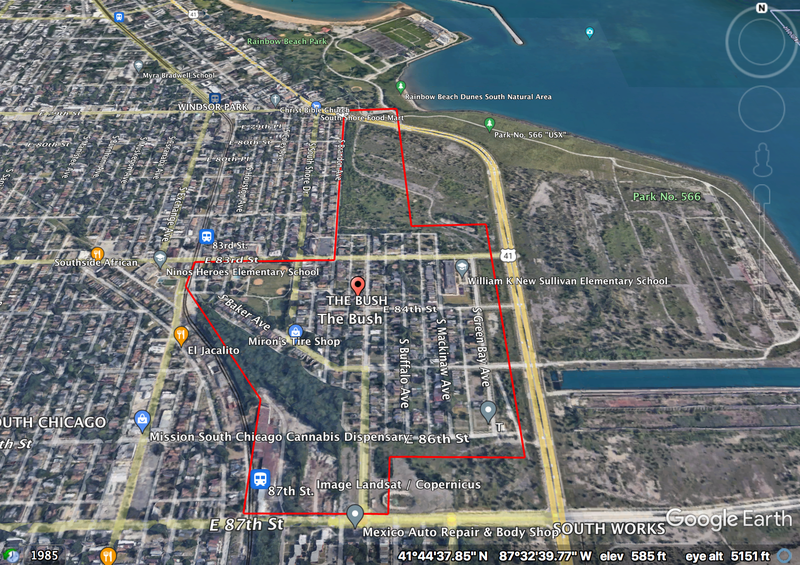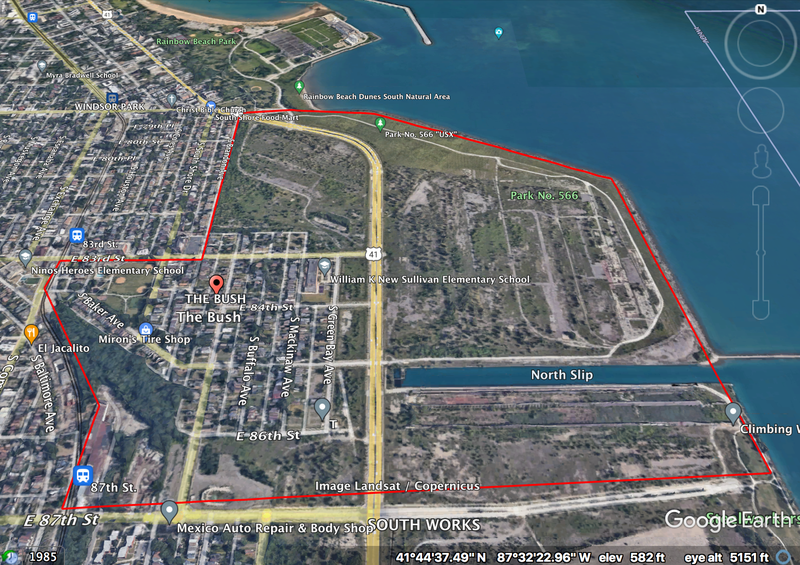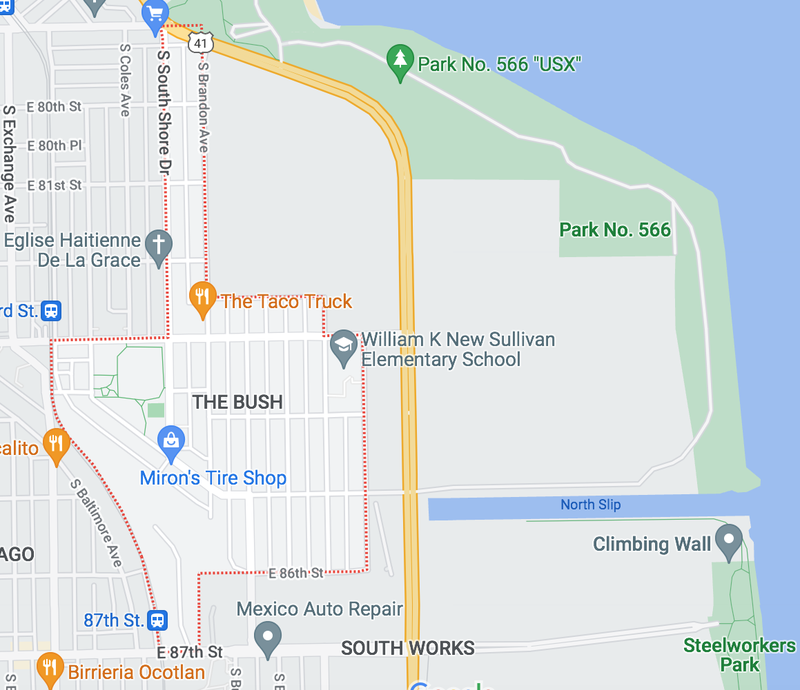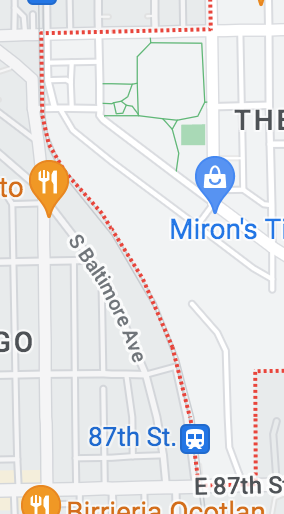Overview
Size


The total population of the Bush is about 2,500. If one excludes the parks that are adjacent to the Bush, which is done in many maps of the Bush on the internet, the neighborhood has an estimated perimeter of 2.94 miles and an estimated area of 179.16 acres. If one includes the parks, the Bush’s estimated perimeter increases to 3.8 miles and its estimated area increases to 510 acres.
Source for population: https://www.socialexplorer.com/73a2f5df75/explore?openold=true
Identity
One aspect of the Bush that provides it a sense of coherence is its street art, which mostly revolves around love, rebuilding, and hope for the future. When juxtaposed with the many destroyed and uninhabitable homes in the neighborhood, this art conveys that the Bush’s residents have pride in where they live but also want more investment into the neighborhood’s future.
There is a strong Catholic presence in the neighborhood due to St. Michael the Archangel Catholic Church, which towers over all other buildings.
Another aspect of the Bush’s identity are the remnants of its industrial past. On my walk through the neighborhood, I saw abandoned iron and tire shops, a lot where affordable welding takes place, junk yards, and large wooded areas and grasslands that were closed off by the United States Steel Corporation. East of the homes of the Bush is the Steelworkers park, which is what remains of the South Works steel manufacturing plant.
The consistent styles of homes in the Bush also add to its identity. Along South Shore Drive and Brandon Avenue, from 80th to 83rd, the homes are mostly bungalows and two-story apartment buildings. Throughout the rest of the neighborhood, the style of homes is the frame two-flat, which are older homes that once served as a bridge for the working class between apartment life and bungalows.
Source: https://chicago.curbed.com/2015/9/3/9924658/also-home-prints
The final aspect of the Bush’s identity that I noticed during my walk was the race of its residents. The residents of the neighborhood are mostly Black and Latin, which is typical of South Chicago as a whole. Some homes had Mexican flags on their porches and others had Black Lives Matter flags in their windows.
Layers
The Bush, without considering its neighboring parks, has a Texas shape. I firstly added the layer of Cook County Census Tracts, which are red lines that intersect with the Texas shape of the neighborhood and extend out of it. The Census Tracts in the Bush are 4601 and 4602. I added another layer, which was Chicago’s alderman wards. The Blue colored ward is ward 7 and the yellow colored ward is ward 10.
Diagram
History
One can begin their exploration into the history of the Bush by looking at early settlement around Chicago’s rivers. In 1833, Jefferson Davis, who is famously known as the past president of the Confederate States of America, was assigned by the government to conduct a survey for a ship canal that would connect Lake Michigan to the Mississippi River. Davis, who was a captain of the U.S. Army Corps of Engineers at the time, argued that the piers should be built at the mouth of the Calumet River (Hmurovic). To his dismay, the canal was not built at that location. Instead the Calumet Harbor was constructed, and it became a major shipping port (Washington High School).
After the construction of the Calumet Harbor, speculators began to buy land around the Calumet River. They expected this land to become very valuable because it would bridge the divide between railroad and river shipping routes. The town that this land was on was called Ainsworth, and it was mostly settled by Irish Catholics. The four communities of Ainsworth were the Bush, Millgate Cheltenham, South Chicago, and Calumet (Encyclopedia of Chicago).
In 1861, the Illinois General Assembly created the Hyde Park Township. Ainsworth was annexed into that township, and it also started to become more commonly referred to as South Chicago at that point (Encyclopedia of Chicago).
The 1860s and 1870s were pivotal moments for the development of industry in the Bush and in South Chicago in general (Sellers). In 1869, James Bowen and other investors founded the Calumet and Chicago Canal and Dock Company. Bowen and the other investors purchased land in the Calumet region in the 1870s. Their company also lobbied Congress for legislation and they were provided with funds to deepen the river and improve facilities. The enhancement of the Calumet Harbor by Bowen’s company and other companies led to the development of more industries as well as attraction of workers to the Bush and to South Chicago in general, especially after the home destruction from the Chicago Fire of 1871 (Southeast Chicago Archive).
In the 1880s, the North Chicago Rolling Mill, later known as South Works, moved to the Southeast side. Advantages that the Southeast side provided for the steel mill included shipping routes for iron ore, coke, and limestone. There were also many skilled workers who moved to the area due to previously stated reasons. South Works quickly became a major source of employment for the residents of the Bush and it continued to be well into the 20th century (Sperling).
The Hyde Park Township, of which South Chicago/Ainsworth was a part, was annexed into Chicago in 1889. At that time, the steel industry was booming on the Southeast side. This resulted in U.S. Steel acquiring South Works in 1901 and expanding its facility to 79th street. African American workers, in particular, worked as stevedores, which are people who load and unload cargo from ships. Their families were pushed to live in neighborhoods near the Chicago River, such as the Bush, which had the worst quality housing. And as South Works’ business continued to develop and cause environmental conditions in surrounding neighborhoods to severely worsen, the Bush’s initial residents, the Irish, moved out to better neighborhoods on the East Side (Encyclopedia of Chicago).
During World War I, Mexican immigrants began to be employed at U.S. Steel. These immigrants were specifically hired as strikebreakers during the 1919 U.S. Steel Strike. Their families were also pushed into living in the Bush due to segregationist pressures from white residents. The ethnic divisions in the Bush and in South Chicago were clearly present and strong, but they were generally bridged starting in the 1930s by Catholic religion, Democratic party involvement, and worker unionization (Encyclopedia of Chicago).
For decades, South Works was a pillar of the Bush’s and South Chicago’s economic functioning. By the 1960s, over 20,000 people from these and other neighborhoods were employed there. But when South Works began to decline in the 1980s, the economy of the Bush and South Chicago declined as well. And by the 1990s, when South Works was completely shut down, the economies of these Southeast side neighborhoods were destroyed (Encyclopedia of Chicago).
While taking a walk through the Bush, one can clearly see the lasting effects of South Works’ shut down. There are few local businesses and many houses sit in an uninhabitable state. Residents of the Bush and of South Chicago live amidst this lasting collapse everyday, and they have pushed the city to provide resources for redevelopment. Throughout the 2000s and 2010s, community groups from these areas have submitted redevelopment plans (United Way of Metro Chicago). The city has also approved for LEED neighborhood developments for the South Chicago neighborhood multiple times within the last 15 years (Olson).
Sources:
Bensman, D. (n.d.). South Chicago. Encyclopedia of Chicago. Retrieved October 15, 2022, from http://www.encyclopedia.chicagohistory.org/pages/1170.html
Bowen High School. Southeast Chicago Archive & Storytelling Project. (2021, April 30). Retrieved October 15, 2022, from https://www.sechicagohistory.org/archive/browse/bowen-high-school/
Hmurovic, J. (2018, June). What do Jefferson Davis, Winston Churchill's father, president Grover Cleveland, Jack Johnson and Wyatt Earp have in common? Whiting-Robertsdale Historical Society. Retrieved October 15, 2022, from https://www.wrhistoricalsociety.com/jefferson-davis
Olson, W. (2009, May 13). South Chicago Leed Neighborhood Development. Green Bean Chicago RSS. Retrieved October 15, 2022, from https://web.archive.org/web/20090720005350/http://www.greenbeanchicago.com/south-chicago-leed-neighborhood-development-green-chicago/
Sellers, R. (2006, March). Chicago's Southeast Side Industrial History. Chicago State University. Retrieved from https://www.csu.edu/cerc/researchreports/documents/ChicagoSESideIndustrialHistory.pdf
South Chicago - United Way of Metro Chicago Neighborhood Network. United Way of Metro Chicago. (2020, December 4). Retrieved October 15, 2022, from https://liveunitedchicago.org/neighborhood-networks/south-chicago/
Sperling, D. (2011, April 9). South Chicago Industry- US Steel South Works. Northeastern Illinois University. Retrieved October 15, 2022, from https://web.archive.org/web/20110409183720/http://www.neiu.edu/~reseller/scussteel.html
- 8. Washington High School. (n.d.). Chicago's Southeast Side: An Environmental History Industry vs. Nature. Southeast Chicago History. Retrieved from https://www.sechicagohistory.org/wp-content/uploads/2020/12/Environmental-History-1.pdf


Social Mix
The following basic demographic tables depict The Bush’s diversity through multiple categories. The Bush is unevenly split into two census tracts, and some of resident data of the adjacent neighborhood, South Chicago, is included in each of the tracts. I could not split up The Bush from South Chicago in a more precise way on Social Explorer, so the data below is not the most representative of my neighborhood. However, all residents of The Bush are encapsulated in the data. So one can still gain a well-defined sense of the diversity that makes up these residents by viewing the data. The columns of the table below are categories, sub-categories, tract numbers, and a weighted average total. The weighted average totals were provided by Social Explorer when I downloaded the census data for tracts 4601 and 4602. And as implied by what I have mentioned so far, all data below is courtesy of Social Explorer.
Next, I will continue with a diversity comparison between The Bush, the community area it belongs to, the region it belongs to, and the city of Chicago as a whole. I will conclude with a diversity analysis of The Bush.
The diversity indexes of income, race/ethnicity, and education for The Bush neighborhood of Chicago are very comparable to those of the city as a whole. Beginning with income, The Bush had a decently balanced distribution throughout different income levels. About 40% of households had a 2020 income of less than $25,000, about 23% had an income between $25,000-$49,999, another 23% had an income between $50,000-$75,000, and fewer than 15% had incomes over $75,000. This distribution is sensible because the median income of the neighborhood was about $35,000. The distribution also conveys diversity in income, as shown by the Simpson’s Diversity Index score. Most residents of the Bush are distributed between lower working class, working class, and lower middle class and a smaller percentage are upper middle class and above. Chicago as a whole was also fairly income diverse, but had significantly higher amounts of households making more than $75,000. The median income for Chicago was also over $60,000, so this difference in the distribution between The Bush and Chicago is sensible. Chicago’s distribution conveys higher diversity than The Bush because residents of each income class, namely working class, middle class, and upper class, make up over 20% of the total population. Continuing, based on the Simpson’s Diversity Index and data from Social Explorer, both The Bush and Chicago are not very diverse based on race/ethnicity. The Bush’s residents are mostly Black or African American and Hispanic or Latino. Chicago’s residents are mostly White, Black or African American, and Hispanic or Latino, which makes the slight difference in the city’s and the Bush’s Simpson’s Diversity Indexes sensible. The Bush's and Chicago's diversity index for race/ethnicity appear to me to be quite low though. It seems to me that, for example for Chicago, 34% White, 29% Black, 29% Hispanic or Latino, and 7% Asian is a fairly diverse distribution. I am wondering how much weight the additional categories of American Indian and Alaska Native, Native Hawaiian and other Pacific Islander, and other place on the calculation of the diversity index. I also chose Hispanic or Latino by race for the race/ethnicity data, due to its breadth, which had a different breakdown by category than other race/ethnicity data groups. Perhaps I would have seen more diversity with the index if the categories were organized differently. Finally, The Bush and Chicago are not diverse based on education. Most residents of The Bush are either high school graduates alone (77%) or high school graduates who completed some college (53%). The same is true for the city, but with even higher percentages of high school graduates alone (86%) and high school graduates who completed some college (64%).
In conclusion, The Bush is most diverse with respect to income, but it is not diverse in the other two variables I explored. Compared to the city as a whole, The Bush is slightly less diverse with respect to income and race/ethnicity and more diverse with respect to education.
Source:
Social Explorer Tables: ACS 2020 (5-Year Estimates) (SE), ACS 2020 (5-Year Estimates), Social Explorer; U.S. Census BureauEDIT
Since my original calculations of the Simpson's Diversity Index for race seemed a bit off, I redid them. This time, I used a more general race category that did not distinguish between Hispanic and non-Hispanic populations. The numbers I got were definitely more sensible than my original numbers. Chicago had the highest diversity index, which makes sense given the distribution of residents between White, Black, Asian, Other Races, and Two or More Races. The Bush had the second highest diversity of the regions I analyzed, which is surprising because of how small it is compared to those other regions. I figure this is because The Bush has a more rigid and even divide between Black residents and White-Hispanic and non-White Hispanic residents. My original conclusion still stands: Chicago is more diverse than the Bush with respect to race.